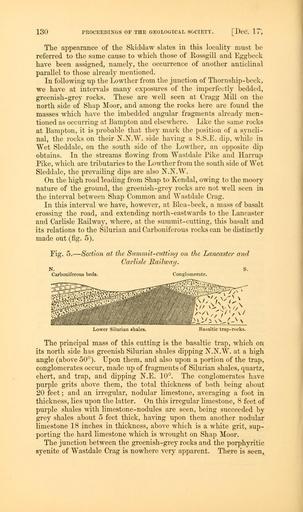MAKE A MEME
View Large Image

| View Original: | The_Quarterly_journal_of_the_Geological_Society_of_London_(12646179964).jpg (1226x2069) | |||
| Download: | Original | Medium | Small | Thumb |
| Courtesy of: | commons.wikimedia.org | More Like This | ||
| Keywords: The Quarterly journal of the Geological Society of London (12646179964).jpg 130 <br> PROCEEDINGS OF THE GEOLOGICAL SOCIETY DeC 17 <br> The appearance of the Skiddaw slates in this locality must be <br> referred to the same cause to which those of Rossgill and Eggbeck <br> have been assigned namely the occurrence of another anticlinal <br> parallel to those already mentioned <br> In following up the Lowther from the junction of Thornship-bcck <br> we have at intervals many exposures of the imperfectly bedded <br> greenish-grey rocks These are well seen at Cragg Mill on the <br> north side of Shap Moor and among the rocks here are found the <br> masses which have the imbedded angular fragments already men- <br> tioned as occurring at Bampton and elsewhere Like the same rocks <br> at Bampton it is probable that they mark the position of a syncli- <br> nal the rocks on their N W side having a S S E dip while in <br> Wet Sleddale on the south side of the Lowther an opposite dip <br> obtains In the streams flowing from Wastdale Pike and Harrup <br> Pike which are tributaries to the Lowther from the south side of Wet <br> Sleddale the prevailing dips are also N jN\W <br> On the high road leading from Shap to Kendal owing to the moory <br> nature of the ground the greenish-grey rocks are not well seen in <br> the interval between Shap Common and Wastdale Crag <br> In this interval we have however at Blea-beck a mass of basalt <br> crossing the road and extending north-eastwards to the Lancaster <br> and Carlisle Railway where at the summit- cutting this basalt and <br> its relations to the Silurian and Carboniferous rocks can be distinctly <br> made out fig 5 <br> Fig 5 ” Section at the Summit-cutting on the Lancaster and <br> Carlisle Railway <br> s <br> N <br> Carboniferous beds <br> -C S <br> Conglomerate <br> mH /A i <br> Lower Silurian shales <br> Basaltic trap-rocks <br> The principal mass of this cutting is the basaltic trap which on <br> its north side has greenish Silurian shales dipping X N W at a high <br> angle above 50° Upon them and also upon a portion of the trap <br> conglomerates occur made up of fragments of Silurian shales quartz <br> chert and trap and dipping N E 10° The conglomerates have <br> purple grits above them the total thickness of both being about <br> 20 feet ; and an irregular nodular limestone averaging a foot in <br> thickness lies upon the latter On this irregular limestone 8 feet of <br> purple shales with limestone-nodules are seen being succeeded by <br> grey shales about 5 feet thick having upon them another nodular <br> limestone 18 inches in thickness above which is a white grit sup- <br> porting the hard limestone which is wrought on Shap Moor <br> The junction between the greenish-grey rocks and the porphyritic <br> syenite of Wastdale Crag is nowhere very apparent There is seen 35328089 109632 51125 Page 130 Text v 19 http //www biodiversitylibrary org/page/35328089 1863 Geological Society of London Biodiversity Heritage Library The Quarterly journal of the Geological Society of London v 19 1863 Geology Periodicals Smithsonian Libraries bhl page 35328089 dc identifier http //biodiversitylibrary org/page/35328089 smithsonian libraries Information field Flickr posted date ISOdate 2014-02-20 Check categories 2015 August 26 CC-BY-2 0 BioDivLibrary https //flickr com/photos/61021753 N02/12646179964 2015-08-27 12 00 27 cc-by-2 0 PD-old-70-1923 The Quarterly journal of the Geological Society of London 1863 Photos uploaded from Flickr by Fæ using a script | ||||